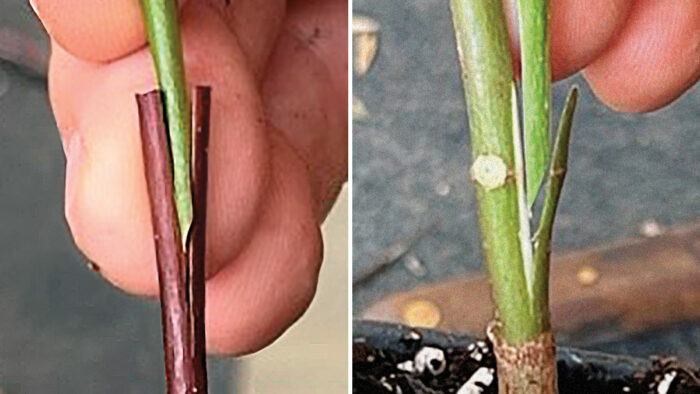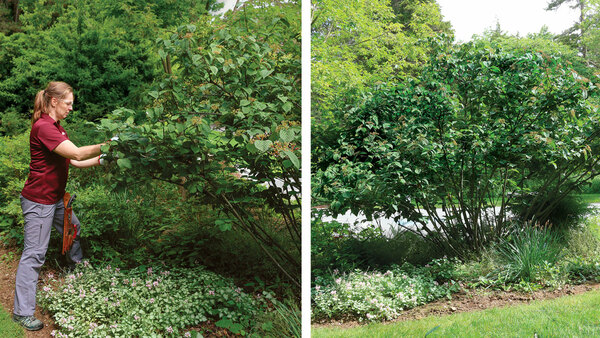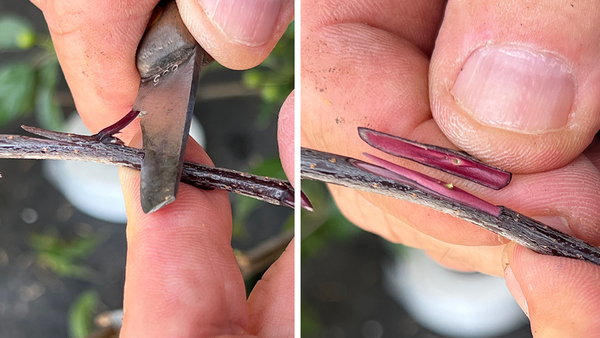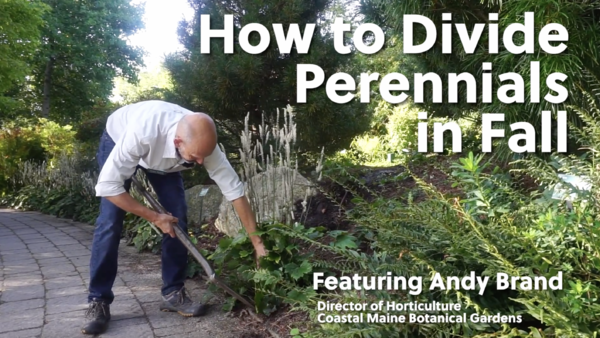
Cleft and side veneer are two frequently used grafting methods in horticulture. Each has its pros and cons. Some species have also shown to do better with one method over the other. Here’s what you need to know before attempting to graft with these techniques.
Technique 1: How to perform cleft grafting
Cleft grafting is used on many trees and shrubs and can help achieve a certain form, such as the umbrella habit of weeping cherries (Prunus pendula and cvs., Zones 5–8), in which it benefits the scion to come directly out of the top of the understock to create a stout, strong trunk. This method usually works better with larger understocks, which means the grafted trees need more growing space; often this is found in a field. The downside to cleft grafting is the lack of growth activity above the graft, which results in less transmission of nutrients and hormones in the vascular cambium tissue and can lead to slower healing of the graft union. However, it’s usually easier to make the cuts for cleft grafting than for side veneer.
Preparing the understock
1. Cut off the understock stem (opposite the root system) flat across with a very sharp hand pruner. The height of the stem where you choose to make the cut depends on the species you are grafting. Then make a 1-inch incision directly down the center of the understock stem (photo). The incision must be clean, smooth, and parallel to the sides of the stem.
Preparing the scion
2. The scion should be a 4- to 6-inch piece of stem (photo A). Make two opposing angled cuts on both sides of the scion (photo B), ending in a wedge with a sharp, pointed bottom (photo C). Be sure that the caliper of the scion stem is similar to the caliper of the understock stem.
Creating the graft
3. The scion should be able to slide into the cut in the understock so that the cambium layers on both sides match (photo A). It’s important not to have excessive open cuts on the scion extending above the graft incision. Secure the graft with rubber grafting tape (photo B), and wrap budding tape around it to create an airtight seal (photo C), which helps prevent dessication.
Technique 2: How to perform side-veneer grafting
Plants such as dogwoods (Cornus spp. and cvs., Zones 2–9), rhododendrons (Rhododendron spp. and cvs., Zones 3–9), and Japanese maples (Acer palmatum and cvs., Zones 5–9) can be grafted using side veneer. This method works best for potted understocks and therefore requires less growing space. Side-veneer graft unions tend to heal more quickly than cleft-grafting graft unions. But side veneer is more technical, and making precise cuts is more difficult than with cleft grafting.
Preparing the understock
1. Make a shallow 1- to 1¼-inch-long incision in the side of the understock stem. This shallow incision will create a flap. In a healthy understock, the cambium layer is clear and visible.
Preparing the scion
2. Prepare the scion by trimming a 1½-inch straight stem section with about 6 to 8 inches of foliage above it. Then cut a shallow 1-inch-long incision on one side of the scion. Be sure the caliper of the scion stem is similar to that of the understock stem.
 |
 |
3. On the back side of the scion make a shallow incision, with the length of the cut matching that of the understock flap. On the bottom (basil) end of the scion, make a clean cut at a 30° angle.
Creating the graft
4. Insert the scion gently into the flap created in the understock. The 30° cut on the scion should face toward the flap on the understock. Make sure the incisions are matched up perfectly.
 |
 |
5. Once the scion is inserted into the understock, secure the graft with grafting strips and/or tape. Chip budding is used to create bareroot trees Chip budding is a grafting method that’s very similar to side veneer, except that a bud is used as a scion instead of a stem. This is often done on understocks planted in the field. In chip budding, an understock from a plant such as an apple tree is planted in spring. In July or August, the understock stem is cleaned of side branches, a flap is cut, and a bud is inserted into the incision.

Chip budding is used to create bareroot trees
Chip budding is a grafting method that’s very similar to side veneer, except that a bud is used as a scion instead of a stem. This is often done on understocks planted in the field. In chip budding, an understock from a plant such as an apple tree is planted in spring. In July or August, the understock stem is cleaned of side branches, a flap is cut, and a bud is inserted into the incision.
Brian Decker is a horticulturalist and owner of Decker’s Nursery in Groveport, Ohio, a wholesale nursery that specializes in plant propagation and grafting.
Photos: courtesy of Pam Dukes
More on grafting:
Fine Gardening Recommended Products

Gardener's Log Book from NYBG
Fine Gardening receives a commission for items purchased through links on this site, including Amazon Associates and other affiliate advertising programs.

Pruning Simplified: A Step-by-Step Guide to 50 Popular Trees and Shrubs
Fine Gardening receives a commission for items purchased through links on this site, including Amazon Associates and other affiliate advertising programs.























Comments
Log in or create an account to post a comment.
Sign up Log in